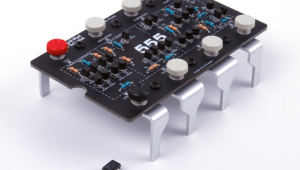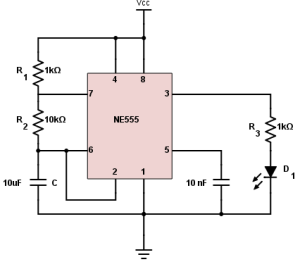I. Introduction
A. Overview of the 555-Timer IC
Within the electronics industry, the 555-Timer integrated circuit has become one of the most popular since it was first introduced by Signetics in 1972. Due to its versatility in producing precise time delays, oscillation, and pulse-width modulation, it is indispensable in a wide range of applications, including voltage regulators and timing circuits.

B. Importance of simplifying its use
It is crucial to make the use of the 555-Timer IC as simple as possible in the current electronics environment. Making this crucial component more widely available encourages innovation, speeds up design processes, and enables both inexperienced and seasoned engineers to accomplish their objectives more quickly as technology develops and demands rise.
II. Understanding the 555 Timer
A. Basic functioning and components
A flip-flop, a voltage divider network, and three internal comparators power the 555 timer. Astable, monostable, and bistable are its three operating modes when it is actuated. To generate the required timing functions, a voltage supply, resistors, and capacitors are among the components.
B. Common applications
The 555 Timer is used in many different applications, including frequency modulation, pulse generation, LED flashing, and pulse-width modulation (PWM) for motor control. It is a mainstay in both amateur and professional electronic designs due to its reliability and adaptability.

B. Common applications
The 555 Timer is used in many different applications, including frequency modulation, pulse generation, LED flashing, and pulse-width modulation (PWM) for motor control. It is a mainstay in both amateur and professional electronic designs due to its reliability and adaptability.
III. Challenges Facing Users
A. Complexity in calculations and configurations
Users often encounter complexity when calculating timing intervals or configuring the 555 timer for specific tasks. Understanding the relationships between resistors, capacitors, and timing formulas can be daunting, especially for beginners. This complexity can hinder the efficient utilization of the 555 timers in electronic projects.
B. Limited resources for simplification
Despite its widespread use, resources dedicated to simplifying the operation and configuration of the 555 timer are relatively limited. Comprehensive guides or tools tailored to address common user challenges could greatly enhance accessibility and usability. Simplification efforts would benefit both novices and experienced engineers seeking efficient design solutions.
IV. Simplified Approach
A. Streamlined methods for calculations
Calculations for the 555 Timer can be made simpler by segmenting difficult timing formulas into smaller, more manageable parts. Resistor and capacitor values for specified timing intervals can be readily determined with the use of methods like internet calculators or established equations. These simplified techniques lessen mistakes and improve process accessibility for users of all skill levels.
B. User-friendly tools and resources
User-friendly tools and resources, including software applications, interactive tutorials, and educational materials, play a crucial role in simplifying the utilization of the 555 timer. These resources provide guidance, simulation capabilities, and practical examples to help users understand its operation and implement it effectively in their projects.
V. Benefits of Simplification
A. Increased accessibility for beginners
Making the 555 Timer easier to use improves accessibility, especially for those just starting in the world of electronics. Novices can more readily understand the principles of timing circuits and confidently use the 555 timer in their projects by simplifying the process and offering precise instructions.
B. Efficiency in design and implementation
Streamlining the use of the 555 timer improves efficiency throughout the design and implementation process. With simplified calculations and user-friendly resources, engineers can quickly prototype circuits, iterate designs, and ultimately bring their projects to fruition in less time and with fewer errors.
VI. Practical Examples
A Step-by-step guide for using the simplified calculator
Giving users a detailed tutorial on how to use the simplified calculator guarantees that they can complete the task with ease. From choosing the right resistor and capacitor values to setting up the 555 timer for particular timing needs, this guide provides users with confidence-boosting clarity and assistance at every turn.
B. Real-world applications and case studies
Case studies and real-world applications show how adaptable and useful the 555 Timer is in a variety of settings. These examples demonstrate how the 555 Timer may be employed across various sectors and projects, stimulating creativity and innovation among users. They range from straightforward LED blinking circuits to more intricate pulse-width modulation for motor speed control.
VII. Conclusion
A. Recap of the importance of simplifying 555 Timer usage
Simplifying 555 timer usage is vital for fostering accessibility and efficiency in electronics projects. By removing barriers to entry and providing user-friendly resources, engineers of all levels can harness the power of this versatile component more effectively. Embracing simplification enhances the learning experience and encourages wider adoption of the 555 timer in diverse applications.
B. Encouragement for further exploration and innovation
Continuing research and development is necessary to push the limits of what can be done with the 555 timer as technology develops. Engineers can push the envelope and spur future developments in electronics design by experimenting with new combinations, incorporating them into creative projects, and disseminating their findings to the community.
